Verify the Address Resolution Protocol (ARP) protocol entries, and synced entries in multi-homing scenarios.
RP/0/RP0/CPU0:router# show arp vrf evpn1
-----------------------------------------------------------------
0/1/CPU0
-----------------------------------------------------------------
Address Age Hardware Addr State Type Interface
10.1.1.1 - 0010.0001.0001 Interface ARPA BVI1
10.1.1.11 02:23:46 1000.0001.0001 Dynamic ARPA BVI1
10.1.1.93 - 0000.f65a.357c EVPN_SYNC ARPA BVI1
10.1.2.1 - 0011.0112.0001 Interface ARPA BVI2
10.1.2.91 02:24:14 0000.f65a.3570 Dynamic ARPA BVI2
10.1.2.93 02:21:52 0000.f65a.357d Dynamic ARPA BVI2
---------------------------------------------------------------
0/0/CPU0
---------------------------------------------------------------
Address Age Hardware Addr State Type Interface
10.1.1.1 - 0010.0001.0001 Interface ARPA BVI1
10.1.1.11 02:23:46 1000.0001.0001 Dynamic ARPA BVI1
10.1.1.93 - 0000.f65a.357c EVPN_SYNC ARPA BVI1
10.1.2.1 - 0011.0112.0001 Interface ARPA BVI2
10.1.2.91 02:24:14 0000.f65a.3570 Dynamic ARPA BVI2
10.1.2.93 02:21:52 0000.f65a.357d Dynamic ARPA BVI2
Verify the adjacency entries, particularly verify newly added information for synced IPv4 and IP ARP entries.
RP/0/RP0/CPU0:router# show adjacency ipv4 BVI 1 internal detail location 0/0/CPU0
BVI1, 10.1.1.93 (ipv4)
Version: 1169, references: 2, transient lock: 0
Encapsulation information (14 bytes) 0000f65a357c0000f65a357c0800 MTU: 1500
Adjacency pointer is: 0x770a9278
Platform adjacency pointer is: 0x7d7bc380
Last updated: Feb 28 15:58:21.998
Adjacency producer: arp (prod_id: 10)
Flags: incomplete adj,
Additional Adjacency Information (4 bytes long),
Upto first 4 bytes (in hex): 01000000
Netio idb pointer not cached Cached interface type: 78
Adjacency references:
bfd_agent (JID 150, PID 3637), 0 reference
l2fib_mgr (JID 185, PID 4003), 0 reference
fib_mgr (JID 294, PID 3605), 1 reference
aib (JID 314, PID 3590), 1 reference
BVI1, 10.1.1.11 (ipv4) Version: 1493,
references: 3, transient lock: 0
Encapsulation information (14 bytes) 1000000100010010000100010800
MTU: 1500
Adjacency pointer is: 0x770ab778
Platform adjacency pointer is: 0x7d7bcb10
Last updated: Mar 2 17:22:00.544
Adjacency producer: arp (prod_id: 10)
Flags: incomplete adj,
Netio idb pointer not cached Cached interface type: 78
Adjacency references:
bfd_agent (JID 150, PID 3637), 0 reference
l2fib_mgr (JID 185, PID 4003), 1 reference
fib_mgr (JID 294, PID 3605), 1 reference
aib (JID 314, PID 3590), 1 reference
Verify the entries to obtain details learnt in L2FIB line cards. In multi-homing active-active scenario, the link-local addresses
are also updated and distributed to EVPN peer gateways.
RP/0/RP0/CPU0:router# show l2vpn mac-learning mac-ipv4 all location 0/RP0/CPU0
Topo ID Producer Next Hop(s) Mac Address IP Address
6 0/0/CPU0 BV1 1000.0001.0001 10.1.1.11
7 0/0/CPU0 BV2 0000.f65a.3570 10.1.2.91
7 0/0/CPU0 BV2 0000.f65a.357d 10.1.2.93
RP/0/RP0/CPU0:router# show l2vpn mac-learning mac-ipv6 all location 0/RP0/CPU0
Topo ID Producer Next Hop(s) Mac Address IP Address
6 0/0/CPU0 BV1 0000.f65a.357c fe80::200:f6ff:fe5a:357c
7 0/0/CPU0 BV2 0000.f65a.3570 10:1:2::91
7 0/0/CPU0 BV2 0000.f65a.357d 10:1:2::93
7 0/0/CPU0 BV2 0000.f65a.3570 fe80::200:f6ff:fe5a:3570
Verify sequence ID for VM mobility.
RP/0/RP0/CPU0:router# show l2route evpn mac-ip all detail
Sun Apr 30 18:09:19.368 PDT
Flags: (Stt)=Static; (L)=Local; (R)=Remote; (F)=Flood;
(N)=No Redistribution; (Rtr)=Router MAC; (B)=Best Route;
(P)=Probe; (S)=Peer Sync; (F)=Flush;
(D)=Duplicate MAC; (Z)=Frozen MAC;
Topo ID Mac Address IP Address Prod Next Hop(s) Seq No Flags Opaque Data Type Opaque Data Len Opaque Data Value
------- ----------- ---------- ---- ---------- ------ ----- ---------------- --------------- -----------------
33 0022.6730.0001 10.130.0.2 L2VPN Bundle-Ether6.1300 0 SB 0 12 0x06000000 0x22000080 0x00000000
Last Update: Sun Apr 30 15:00:01.911 PDT
33 0022.6730.0002 10.130.0.3 LOCAL Bundle-Ether6.1300 0 B N/A N/A N/A
RP/0/RP0/CPU0:router# show l2route evpn mac all detail
Flags: (Stt)=Static; (L)=Local; (R)=Remote; (F)=Flood;
(N)=No Redistribution; (Rtr)=Router MAC; (B)=Best Route;
(S)=Peer Sync; (Spl)=Split; (Rcv)=Recd;
(D)=Duplicate MAC; (Z)=Frozen MAC;
Topo ID Mac Address Prod Next Hop(s) Seq No Flags Slot ESI Opaque Data Type Opaque Data Len Opaque Data Value
-------- -------------- ------ ----------- ------ ------ ---- ---- ---------------- --------------- -----------------
36 0022.5830.0001 L2VPN Bundle-Ether5.1300 0 BSSpl 0 (F) 0 12 0x06000000 0x25000080 0x00000000
Last Update: Thu Apr 20 09:04:44.358 PDT
Configuration Example
/* Mac Address Duplicate Detection Configuration */
Router# configure
Router(config)# evpn
Router(config-evpn)# host mac-address duplicate-detection
Router(config-evpn-host-mac-addr-dup-detection)# move-count 2
Router(config-evpn-host-mac-addr-dup-detection)# freeze-time 10
Router(config-evpn-host-mac-addr-dup-detection)# retry-count 2
Router(config-evpn-host-mac-addr-dup-detection)# commit
Running Configuration
Verify the entries to obtain details learnt in L2FIB RP when it is an aggregator. Route processor (RP) entries are aggregated
entries obtained from the line cards. In some cases of MAC move, there could be different states for the same MAC. This is
displayed in RP aggregated entries. RP determines the update to be sent to L2RIB according to MAC-Learning algorithms.
RP/0/RP0/CPU0:router# show l2vpn mac-learning mac-ipv4 all location 0/RP0/CPU0
Topo ID Producer Next Hop(s) Mac Address IP Address
------- -------- ----------- -------------- ----------
6 0/0/CPU0 BV1 1000.0001.0001 10.1.1.11
7 0/0/CPU0 BV2 0000.f65a.3570 10.1.2.91
7 0/0/CPU0 BV2 0000.f65a.357d 10.1.2.93
Verify the entries in L2RIB that are updated by RP L2FIB. Note the following when you verify the entries:
-
The entries with producer as L2VPN and NH as remote IP are learnt from the remote peer gateways, which are learnt from BGP,
updated to EVPN, and then updated to L2RIB. So these entries are not from local IP-MAC learning.
-
The entries with producer as L2VPN and NH as local bundle interfaces are synced entries from MH-AA peer gateway.
-
The entries with producer as LOCAL and NH as local bundle interfaces are dynamically learnt local entries.
RP/0/RP0/CPU0:router# show l2route evpn mac-ip evi 6
Topo ID Mac Address IP Address Prod Next Hop(s)
-------- -------------- --------------- ------ -------------
6 0000.f65a.3569 10.1.1.101 L2VPN 172.16.0.2/24014/ME
6 0000.f65a.3575 10.1.1.97 L2VPN 172.16.0.7/24025/ME
6 0000.f65a.3575 10:1:1::97 L2VPN 172.16.0.7/24025/ME
6 0000.f65a.3575 fe80::200:f6ff:fe5a:3575 L2VPN 172.16.0.7/24025/ME
6 0000.f65a.357c 10.1.1.93 L2VPN Bundle-Ether1.11
6 0000.f65a.357c 10:1:1::93 L2VPN Bundle-Ether1.11
6 0000.f65a.357c fe80::200:f6ff:fe5a:357c LOCAL Bundle-Ether1.11
6 0010.0001.0012 10.1.1.12 L2VPN 172.16.0.7/24025/ME
6 1000.0001.0001 10.1.1.11 LOCAL Bundle-Ether1.11
6 90e2.ba8e.c0c9 10.1.1.102 L2VPN 172.16.0.2/24014/ME
Verify entries to obtain details of EVPN.
RP/0/RP0/CPU0:router# show evpn evi vpn-id 1 mac ipv4 10.1.1.93 detail
EVI MAC address IP address Nexthop Label
---- --------------- ---------- ---------- -----
1 0000.f65a.357c 10.1.1.93 172.16.0.2 24014
Ethernet Tag : 0
Multi-paths Resolved : True
Static : No
Local Ethernet Segment : N/A
Remote Ethernet Segment : 0100.6cbc.a77c.c180.0000
Local Sequence Number : N/A
Remote Sequence Number : 0
Local Encapsulation : N/A
Remote Encapsulation : MPLS
Verify local BGP entries with appropriate second label and second IP VRF route-target.
RP/0/RP0/CPU0:router# show bgp l2vpn evpn rd 172.16.0.1:1 [2][0][48][0000.f65a.357c][32][10.1.1.93]/136
BGP routing table entry for [2][0][48][0000.f65a.357c][32][10.1.1.93]/136, Route Distinguisher: 172.16.0.1:1
Versions:
Process bRIB/RIB SendTblVer
Speaker 3772 3772
Local Label: 24013
Last Modified: Feb 28 16:06:37.073 for 2d19h
Paths: (2 available, best #1)
Advertised to peers (in unique update groups):
172.16.0.9
Path #1: Received by speaker 0
Advertised to peers (in unique update groups):
172.16.0.9
Local
0.0.0.0 from 0.0.0.0 (172.16.0.1)
Second Label 24027 >>>> Second label when IRB host-routing is enabled.
Origin IGP, localpref 100, valid, redistributed, best, group-best, import-candidate, rib-install
Received Path ID 0, Local Path ID 0, version 3772
Extended community: SoO:172.16.0.2:1 RT:100:100
EVPN ESI: 0100.6cbc.a77c.c180.0000
Path #2: Received by speaker 0
Not advertised to any peer
Local
172.16.0.2 (metric 101) from 172.16.0.9 (172.16.0.2)
Received Label 24014, Second Label 24031
Origin IGP, localpref 100, valid, internal, add-path, import-candidate, imported, rib-install
Received Path ID 0, Local Path ID 2, version 3769
Extended community: SoO:172.16.0.2:1 RT:200:1 RT:700:100 >>> Second RT is IP VRF RT for remote to import into IP VRF routing table.
Originator: 172.16.0.2, Cluster list: 172.16.0.9
EVPN ESI: 0100.6cbc.a77c.c180.0000
Source AFI: L2VPN EVPN, Source VRF: default, Source Route Distinguisher: 172.16.0.2:1
RP/0/RP0/CPU0:router# show bgp l2vpn evpn rd 172.16.0.1:1 [2][0][48][0000.f65a.357c][128][10:1:1::93]/232
[2][0][48][0000.f65a.357c][128][10:1:1::93]/232
BGP routing table entry for [2][0][48][0000.f65a.357c][128][10:1:1::93]/232, Route Distinguisher: 172.16.0.1:1
Versions:
Process bRIB/RIB SendTblVer
Speaker 3172 3172
Local Label: 24013
Last Modified: Feb 28 11:34:33.073 for 3d00h
Paths: (2 available, best #1)
Advertised to peers (in unique update groups):
172.16.0.9
Path #1: Received by speaker 0
Advertised to peers (in unique update groups):
172.16.0.9
Local
0.0.0.0 from 0.0.0.0 (172.16.0.1)
Second Label 24029
Origin IGP, localpref 100, valid, redistributed, best, group-best, import-candidate, rib-install
Received Path ID 0, Local Path ID 0, version 3172
Extended community: SoO:172.16.0.2:1 RT:100:100
EVPN ESI: 0100.6cbc.a77c.c180.0000
Path #2: Received by speaker 0
Not advertised to any peer
Local
172.16.0.2 (metric 101) from 172.16.0.9 (172.16.0.2)
Received Label 24014, Second Label 24033
Origin IGP, localpref 100, valid, internal, add-path, import-candidate, imported, rib-install
Received Path ID 0, Local Path ID 2, version 3167
Extended community: SoO:172.16.0.2:1 RT:200:1 RT:700:100
Originator: 172.16.0.2, Cluster list: 172.16.0.9
EVPN ESI: 0100.6cbc.a77c.c180.0000
Source AFI: L2VPN EVPN, Source VRF: default, Source Route Distinguisher: 172.16.0.2:1
Verify the remote peer gateway BGP entries with correct label and route-target. Particularly verify the local auto-generated
RD on a remote EVPN gateway. EVPN type-2 routes are imported into EVPN. The host routes of IPv4 /32 addresses are imported
only into IP VRF route-table in the remote EVPN gateway, but not in the local EVPN gateway where local BVI adjacency is used
to overwrite RIB entries.
RP/0/RP0/CPU0:router# show bgp l2vpn evpn rd 172.16.0.7:1 [2][0][48][0000.f65a.357c][32][10.1.1.93]/136
BGP routing table entry for [2][0][48][0000.f65a.357c][32][10.1.1.93]/136, Route Distinguisher: 172.16.0.7:1
Versions:
Process bRIB/RIB SendTblVer
Speaker 16712 16712
Last Modified: Feb 28 16:06:36.448 for 2d19h
Paths: (2 available, best #1)
Not advertised to any peer
Path #1: Received by speaker 0
Not advertised to any peer
Local
172.16.0.1 from 172.16.0.9 (172.16.0.1)
Received Label 24013, Second Label 24027 >>>> First label for L2 MAC unicast bridging; second label for EVPN IRB host-routing
Origin IGP, localpref 100, valid, internal, best, group-best, import-candidate, imported, rib-install
Received Path ID 0, Local Path ID 0, version 16712
Extended community: SoO:172.16.0.2:1 RT:100:1 RT:100:100
Originator: 172.16.0.1, Cluster list: 172.16.0.9
EVPN ESI: 0100.6cbc.a77c.c180.0000
Source AFI: L2VPN EVPN, Source VRF: default, Source Route Distinguisher: 172.16.0.1:1
Path #2: Received by speaker 0
Not advertised to any peer
Local
172.16.0.2 from 172.16.0.9 (172.16.0.2)
Received Label 24014, Second Label 24031
Origin IGP, localpref 100, valid, internal, backup, add-path, import-candidate, imported, rib-install
Received Path ID 0, Local Path ID 1, version 16706
Extended community: SoO:172.16.0.2:1 RT:200:1 RT:700:100
Originator: 172.16.0.2, Cluster list: 172.16.0.9
EVPN ESI: 0100.6cbc.a77c.c180.0000
Source AFI: L2VPN EVPN, Source VRF: default, Source Route Distinguisher: 172.16.0.2:1
RP/0/RP0/CPU0:router# show bgp l2vpn evpn rd 172.16.0.7:1 [2][0][48][0000.f65a.357c][128][10:1:1::93]/232
BGP routing table entry for [2][0][48][0000.f65a.357c][128][10:1:1::93]/232, Route Distinguisher: 172.16.0.7:1
Versions:
Process bRIB/RIB SendTblVer
Speaker 6059 6059
Last Modified: Feb 28 12:03:22.448 for 2d23h
Paths: (2 available, best #1)
Not advertised to any peer
Path #1: Received by speaker 0
Not advertised to any peer
Local
172.16.0.1 from 172.16.0.9 (172.16.0.1)
Received Label 24013, Second Label 24029
Origin IGP, localpref 100, valid, internal, best, group-best, import-candidate, imported, rib-install
Received Path ID 0, Local Path ID 0, version 6043
Extended community: SoO:172.16.0.2:1 RT:100:1 RT:100:100
Originator: 172.16.0.1, Cluster list: 172.16.0.9
EVPN ESI: 0100.6cbc.a77c.c180.0000
Source AFI: L2VPN EVPN, Source VRF: default, Source Route Distinguisher: 172.16.0.1:1
Path #2: Received by speaker 0
Not advertised to any peer
Local
172.16.0.2 from 172.16.0.9 (172.16.0.2)
Received Label 24014, Second Label 24033
Origin IGP, localpref 100, valid, internal, backup, add-path, import-candidate, imported, rib-install
Received Path ID 0, Local Path ID 1, version 6059
Extended community: SoO:172.16.0.2:1 RT:200:1 RT:700:100
Originator: 172.16.0.2, Cluster list: 172.16.0.9
EVPN ESI: 0100.6cbc.a77c.c180.0000
Source AFI: L2VPN EVPN, Source VRF: default, Source Route Distinguisher: 172.16.0.2:1
Verify the remote peer gateway with host routes of IPv4 /32 addresses imported into the IP VRF routing table.
RP/0/RP0/CPU0:router# show bgp vpnv4 unicast vrf evpn1 10.1.1.93/32
BGP routing table entry for 10.1.1.93/32, Route Distinguisher: 172.16.0.7:11
Versions:
Process bRIB/RIB SendTblVer
Speaker 22202 22202
Last Modified: Feb 28 16:06:36.447 for 2d19h
Paths: (2 available, best #1)
Not advertised to any peer
Path #1: Received by speaker 0
Not advertised to any peer
Local
172.16.0.1 from 172.16.0.9 (172.16.0.1)
Received Label 24027
Origin IGP, localpref 100, valid, internal, best, group-best, import-candidate, imported
Received Path ID 0, Local Path ID 0, version 22202
Extended community: SoO:172.16.0.2:1 RT:100:1 RT:100:100
Originator: 172.16.0.1, Cluster list: 172.16.0.9
Source AFI: L2VPN EVPN, Source VRF: default, Source Route Distinguisher: 172.16.0.1:1 >>>> The source from L2VPN and from synced ARP entry.
Path #2: Received by speaker 0
Not advertised to any peer
Local
172.16.0.2 from 172.16.0.9 (172.16.0.2)
Received Label 24031
Origin IGP, localpref 100, valid, internal, backup, add-path, import-candidate, imported
Received Path ID 0, Local Path ID 1, version 22201
Extended community: SoO:172.16.0.2:1 RT:200:1 RT:700:100
Originator: 172.16.0.2, Cluster list: 17.0.0.9
Source AFI: L2VPN EVPN, Source VRF: default, Source Route Distinguisher: 172.16.0.2:1 >>>> source from L2VPN and from dynamic ARP entry
RP/0/RP0/CPU0:router# show bgp vpnv6 unicast vrf evpn1 10:1:1::93/128
BGP routing table entry for 10:1:1::93/128, Route Distinguisher: 172.16.0.7:11
Versions:
Process bRIB/RIB SendTblVer
Speaker 22163 22163
Last Modified: Feb 28 12:09:30.447 for 2d23h
Paths: (2 available, best #1)
Not advertised to any peer
Path #1: Received by speaker 0
Not advertised to any peer
Local
172.16.0.1 from 172.16.0.9 (172.16.0.1)
Received Label 24029
Origin IGP, localpref 100, valid, internal, best, group-best, import-candidate, imported
Received Path ID 0, Local Path ID 0, version 22163
Extended community: SoO:172.16.0.2:1 RT:100:1 RT:100:100
Originator: 172.16.0.1, Cluster list: 172.16.0.9
Source AFI: L2VPN EVPN, Source VRF: default, Source Route Distinguisher: 172.16.0.1:1 >>> Source from L2VPN and from synced ARP entry.
Path #2: Received by speaker 0
Not advertised to any peer
Local
172.16.0.2 from 172.16.0.9 (172.16.0.2)
Received Label 24033
Origin IGP, localpref 100, valid, internal, backup, add-path, import-candidate, imported
Received Path ID 0, Local Path ID 1, version 22163
Extended community: SoO:172.16.0.2:1 RT:200:1 RT:700:100
Originator: 172.16.0.2, Cluster list: 172.16.0.9
Source AFI: L2VPN EVPN, Source VRF: default, Source Route Distinguisher: 172.16.0.2:1 >>> Source from L2VPN and from dynamic ARP entry.
RP/0/RP0/CPU0:router# show bgp vpnv6 unicast vrf evpn1 10:1:1::93/128
BGP routing table entry for 10:1:1::93/128, Route Distinguisher: 172.16.0.7:11
Versions:
Process bRIB/RIB SendTblVer
Speaker 22163 22163
Last Modified: Feb 28 12:09:30.447 for 2d23h
Paths: (2 available, best #1)
Not advertised to any peer
Path #1: Received by speaker 0
Not advertised to any peer
Local
172.16.0.1 from 172.16.0.9 (172.16.0.1)
Received Label 24029
Origin IGP, localpref 100, valid, internal, best, group-best, import-candidate, imported
Received Path ID 0, Local Path ID 0, version 22163
Extended community: SoO:172.16.0.2:1 RT:100:1 RT:100:100
Originator: 172.16.0.1, Cluster list: 172.16.0.9
Source AFI: L2VPN EVPN, Source VRF: default, Source Route Distinguisher: 172.16.0.1:1
Path #2: Received by speaker 0
Not advertised to any peer
Local
172.16.0.2 from 172.16.0.9 (172.16.0.2)
Received Label 24033
Origin IGP, localpref 100, valid, internal, backup, add-path, import-candidate, imported
Received Path ID 0, Local Path ID 1, version 22163
Extended community: SoO:172.16.0.2:1 RT:200:1 RT:700:100
Originator: 172.16.0.2, Cluster list: 172.16.0.9
Source AFI: L2VPN EVPN, Source VRF: default, Source Route Distinguisher: 172.16.0.2:1
Verify local forwarding with local adjacency which overwrite the RIB entries, and remote peer that use the IP VRF host route
entries for IP VPN forwarding.
RP/0/RP0/CPU0:router# show bgp vpnv4 unicast vrf evpn1 10.1.1.93/32
-- For local routing and forwarding
RP/0/RP0/CPU0:PE11-R1#show route vrf evpn1 10.1.1.93
Routing entry for 10.1.1.93/32
Known via "bgp 3107", distance 200, metric 0, type internal
Installed Feb 28 15:57:28.154 for 2d20h
Routing Descriptor Blocks
172.16.0.2, from 172.16.0.9 >>> From MH-AA peer.
Nexthop in Vrf: "default", Table: "default", IPv4 Unicast, Table Id: 0xe0000000
Route metric is 0
No advertising protos.
RP/0/RP0/CPU0:PE11-R1# show cef vrf evpn1 10.1.1.93 location 0/0/CPU0
10.1.1.93/32, version 0, internal 0x1120001 0x0 (ptr 0x7b40052c) [1], 0x0 (0x7b286010), 0x0 (0x0)
Updated Feb 28 15:58:22.688
local adjacency 10.1.1.93
Prefix Len 32, traffic index 0, Adjacency-prefix, precedence n/a, priority 15
via 10.1.1.93/32, BVI1, 2 dependencies, weight 0, class 0 [flags 0x0]
path-idx 0 NHID 0x0 [0x7f531f88 0x0]
next hop
local adjacency >>> Forwarding with local synced ARP adjacency entries.
For remote routing and forwarding:
RP/0/RP0/CPU0:router# show route vrf evpn1 10.1.1.93
Routing entry for 10.1.1.93/32
Known via "bgp 3107", distance 200, metric 0
Number of pic paths 1 , type internal
Installed Feb 28 16:06:36.431 for 2d20h
Routing Descriptor Blocks
172.16.0.1, from 172.16.0.9
Nexthop in Vrf: "default", Table: "default", IPv4 Unicast, Table Id: 0xe0000000
Route metric is 0
172.16.0.2, from 172.16.0.9, BGP backup path
Nexthop in Vrf: "default", Table: "default", IPv4 Unicast, Table Id: 0xe0000000
Route metric is 0
No advertising protos.
RP/0/RP0/CPU0:router# show cef vrf evpn1 10.1.1.93 location 0/0/CPU0
10.1.1.93/32, version 86, internal 0x5000001 0x0 (ptr 0x99fac884) [1], 0x0 (0x0), 0x208 (0x96c58494)
Updated Feb 28 16:06:39.285
Prefix Len 32, traffic index 0, precedence n/a, priority 3
via 172.16.0.1/32, 15 dependencies, recursive [flags 0x6000]
path-idx 0 NHID 0x0 [0x97955380 0x0]
recursion-via-/32
next hop VRF - 'default', table - 0xe0000000
next hop 172.16.0.1/32 via 34034/0/21
next hop 100.0.57.5/32 Te0/0/0/3 labels imposed {ImplNull 24011 24027}
next hop 100.0.67.6/32 Te0/0/0/1 labels imposed {ImplNull 24009 24027}
via 172.16.0.2/32, 11 dependencies, recursive, backup [flags 0x6100]
path-idx 1 NHID 0x0 [0x979554a0 0x0]
recursion-via-/32
next hop VRF - 'default', table - 0xe0000000
next hop 172.16.0.2/32 via 34035/0/21
next hop 100.0.57.5/32 Te0/0/0/3 labels imposed {ImplNull 24012 24031}
next hop 100.0.67.6/32 Te0/0/0/1 labels imposed {ImplNull 24010 24031}
The following sections describe how to verify the subnet stretching.
Verify the VRF.
RP/0/RP0/CPU0:leafW# show run vrf cust130
vrf cust130
address-family ipv4 unicast
import route-target
130:130
!
export route-target
130:130
!
!
!
Verify the BGP configuration.
RP/0/RP0/CPU0:leafW# show run router bgp | begin vrf cust130
vrf cust130
rd auto
address-family ipv4 unicast
label mode per-vrf
maximum-paths ibgp 10
redistribute connected
!
!
Verify the L2VPN.
RP/0/RP0/CPU0:leafW# show run l2vpn bridge group bg130
l2vpn
bridge group bg130
bridge-domain bd130
interface Bundle-Ether1.1300
!
interface Bundle-Ether5.1300
!
routed interface BVI130
evi 130
!
!
!
!






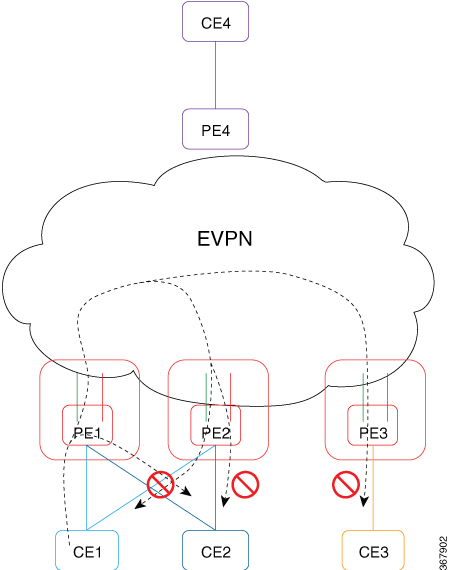

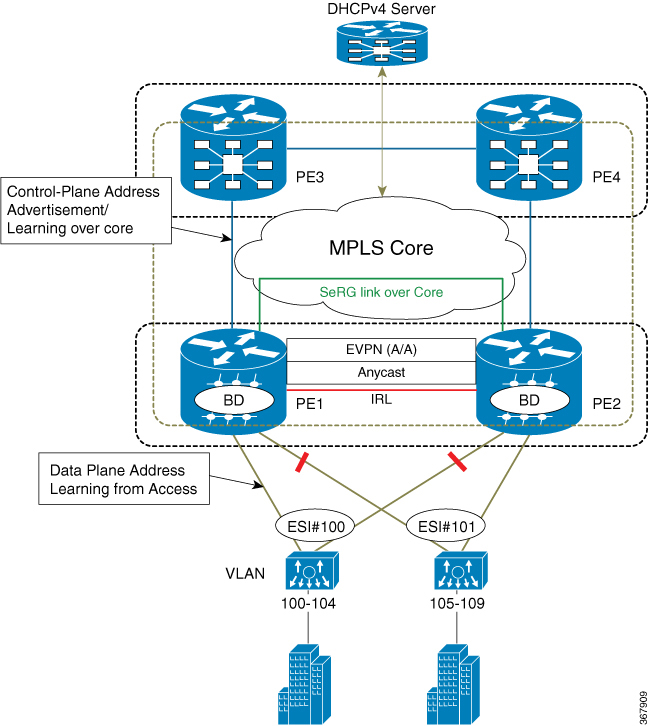
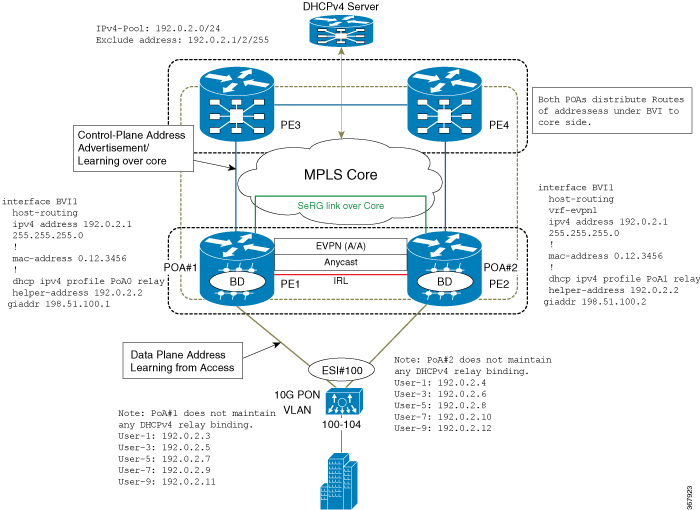
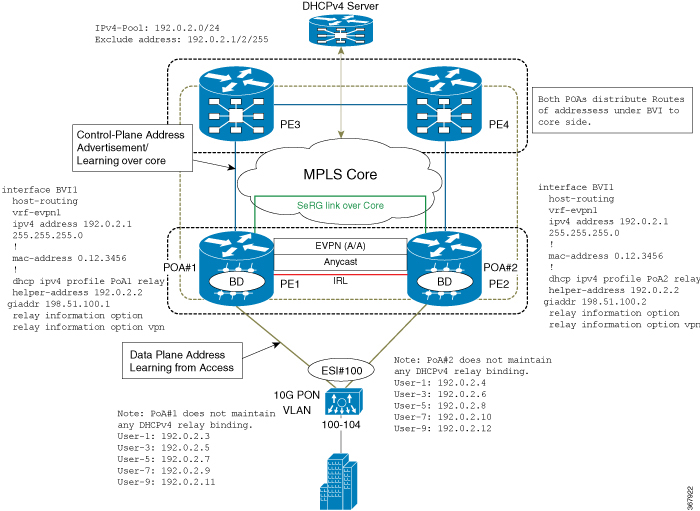
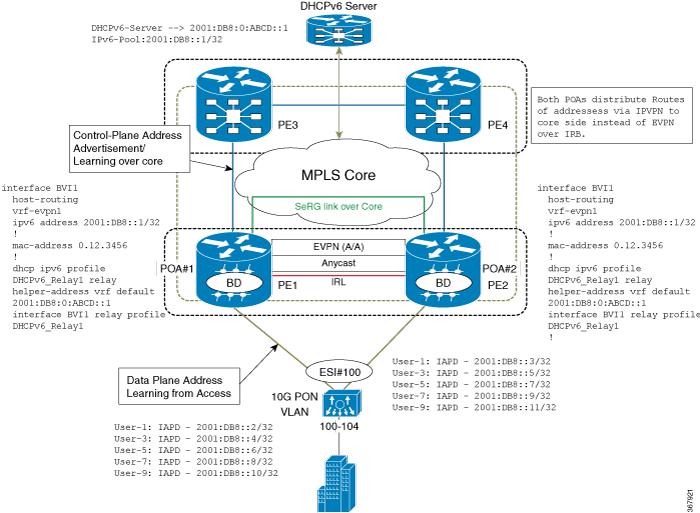
 Feedback
Feedback